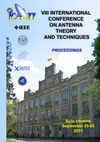Radiation polarization control of the turnstile antenna with impedance vibrators
DOI:
https://doi.org/10.1109/ICATT.2011.6170740Keywords:
turnstile antenna, impedance vibrator, surface impedance, polarization controlAbstract
The problem concerning the creation of the radiation field with circular polarization in the certain direction by turnstile antenna, consisting of the impedance vibrators, excited cophasedly, has been solved on the basis of the solution of the problem about radiation of the thin impedance vibrator over the perfectly conducting plane. The length and the value of the surface impedance of one vibrator are fixed at this, and the problem conditions are satisfied by fitting the length and the surface impedance of the other vibrator. The special case, when a perfectly conducting vibrator is used as a tuning radiator, has been considered. The angular distributions of the coefficient of ellipticity, illustrating the results of calculations, are given.References
BALANIS, C.A. (ed.) Modern Antenna Handbook. Hoboken, New Jersey: John Willey & Sons, 2008, 1680 p., doi: http://dx.doi.org/10.1002/9780470294154.
NESTERENKO, M.V.; KATRICH, V.A.; DAKHOV, V.M. Formation of the radiation field with the set spatial-polarization characteristics by the crossed impedance vibrators system. Radiophysics and Quantum Electronics, 2010, v.53, n.5-6, p.371-378, doi: http://dx.doi.org/10.1007/s11141-010-9236-6.
KORN, G.A.; KORN, T.M. (eds.). Mathematical Handbook for Scientists and Engineers. New York: McGraw-Hill Book Company, 1968.
Published
2011-09-25
Issue
Section
LGA, printed antennas

